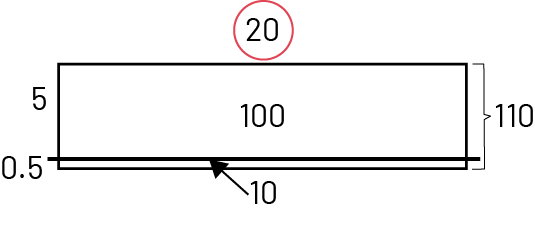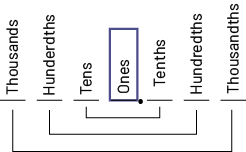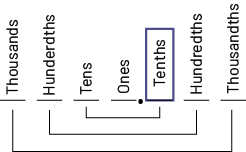B2.8 Represent and solve problems involving the division of three-digit whole numbers by decimal tenths, using appropriate tools, strategies, and algorithms, and expressing remainders as appropriate.
Skill: Representing and Solving Problems Involving the Division of Three-Digit Whole Numbers by Decimal Tenths
By Grade 6, students have learned that a division such as \(12 \div 3\) is performed either in a context of creating groups of 3 elements (grouping sense) or in a context of creating 3 equal groups (sharing sense). These two contexts also exist when dividing a whole number by a decimal number.
Source: translated from Guide d’enseignement efficace des mathématiques de la 4e à la 6e année, Numération et sens du nombre, Fascicule 3, Nombres décimaux et pourcentages, p. 83.
However, when dividing a whole number by a decimal number, the contexts usually call for dividing in the sense of grouping, with the question being, "How many tenths are there in this quantity?".
Source: Ontario Curriculum, Mathematics Curriculum, Grades 1-8, 2020, Ontario Ministry of Education.
Example
A ribbon measuring 110 cm is cut into 5.5 cm pieces to make loops. How many loops can be created?
\(110 \div 5.5 = \;?\)
Estimate
\(\begin{align}110\; \div \;5.5\; &\approx \;100\; \div \;5\\ &\approx \;20\end{align}\)
Division Using Multiplication
\(5.5\; \times \;? = \;110\)
\(5 \times 20 \; = 100\)
\(0.5 \times 20 = 10\)
\(100 + 10 = 110\)
Then, \(5.5 \times 20 = 110\)
20 loops can be created.
Division Using an Area Model

Division of a whole number by a decimal number can be performed using a variety of strategies, which are essentially the same as those used in division situations with whole numbers. However, it is important that students interpret the result correctly. To do this, they must refer to the estimation made beforehand to confirm the order of magnitude of the quotient. They must also refer to the context to ensure that the quotient makes sense, namely, that the result obtained represents a reasonable size or number of groups. Students must also understand and be able to explain the strategy used to perform the operation.
When dividing a decimal number, the operation is often not performed by grouping since representing requires the creating and interpreting of a part of a group, which makes the process more difficult to grasp.
Source: translated from Guide d’enseignement efficace des mathématiques de la 4e à la 6e année, Numération et sens du nombre, Fascicule 3, Nombres décimaux et pourcentages, p 107-108.
A strategy to divide whole numbers by decimal numbers is to create an equivalent division statement using whole numbers.
Source: Ontario Curriculum, Mathematics Curriculum, Grades 1-8, Ontario Ministry of Education, 2020..
Example
Min is reading a 135 page book. Her goal is to read this book in 4.5 days. How many pages does she need to read per day in order to achieve her goal?
Estimation
\(\begin{align}135\; \div \;4.5\; &\approx \;135\; \div \;5\; \\ &\approx \;\left( {100\; \div \;5} \right)\; + \;\left( {35\; \div \;5} \right)\\ &\approx \;20\; + \;7\\ &\approx \;27 \end{align}\)
- Division Using an Equivalent Expression
I divided 135 pages by 4.5 days. An equivalent division using whole numbers is \(1350\; \div \;45\), since I multiplied each number by 10 to eliminate the decimal point.
\(\begin{array}{l}135\; \times \;10\; = \;1350\\4.5\; \times \;10\; = \;45\end{array} \)
\(\begin{array}{l}1350 \div \;45 = \;30 \end{array}\)
Then, \(135 \div 4.5 = 30\)
Min has to read 30 pages a day.
- Division Using an Area Model

The Remainder
In division, the concept of remainder arises when a quotient is not a whole number. For many students, the remainder is just a number that appears in the “recipe” for division (for example, \(178\; \div \;0.8\; = \;222R4\)).
However, when the operation arises from a context, the remainder must be processed in order to adequately address the problem. Thus, students can develop the ability to process the remainder if they occur in a problem-solving situation. There are several ways to process the remainder:
- The remainder is divided equally and expressed as a decimal number.
- The remainder is divided equally and expressed as a fraction.
- The remainder is distributed among the groups.
- The remainder increases the quotient by 1.
- The remainder is the answer.
Source: translated from Guide d’enseignement efficace des mathématiques de la 4e à la 6e année, Numération et sens du nombre, Fascicule 1, Nombres naturels, p 86-87.
Knowledge: Decimal Number
A decimal number is a number that has a decimal point, such as 3.75. The part before the decimal point represents a whole number amount, and the part after the decimal point represents a value that is less than one.
Example
3.72 and 12.135 64
All whole numbers can be expressed as decimals.
Example
\(3\; = \;3.0\)
Some fractions can also be expressed as decimals, such as \(\frac{2}{5}\), which is equal to \(\;0.4\) and \(\frac{3}{16}\), which is equal to 0.1875. We notice then that \(\frac{1}{2}\), \(\frac{5}{10}\) and 0.5 are symbolic representations of the same decimal number.
Source: translated from Guide d’enseignement efficace des mathématiques de la 4e à la 6e année, Numération et sens du nombre, Fascicule 3, Nombres décimaux et pourcentages, p. 28.
Knowledge: Role of the Decimal Point
The decimal point plays a significant role in decimal notation. It separates the whole part from the decimal part.

The position of the ones defines the whole according to which are formed on the one hand the tenths, the hundredths and the thousandths and on the other hand the tens, the hundreds and the thousands. It can therefore be said that the ones, identified by the decimal point, is at the heart of the decimal system.

This recognition of the role of the ones digit is evidenced by the name prefixes given to the place value of the digits on either side of it. Thus, tenths represent a quantity ten times smaller than one and tens are ten times bigger.

Knowledge: Algorithm
Algorithms are sets of rules and ordered actions needed to perform an addition, subtraction, multiplication or division. In simple terms, an algorithm is the "recipe" for an operation. (Kilpatrick, Swafford and Findell, 2001, p. 103).
Standard Algorithm
Standardized method for performing an operation.
Example

Student-Generated Algorithm
A strategy for solving a problem or performing a calculation, usually developed by a student.
Example

Source: translated from Guide d’enseignement efficace des mathématiques de la 4e à la 6e année, Numération et sens du nombre, Fascicule 1, Nombres naturels, p. 76.
